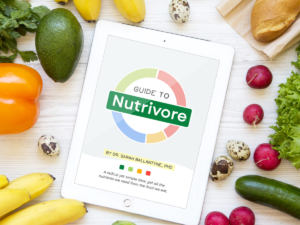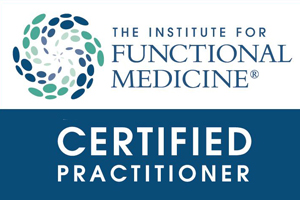This post contains affiliate links. Click here to see what that means.
Where Do Supplements Fit Into A Healing Diet?
With nutrient density and a balanced diet as the priority of the AIP, you might be confused about whether you should also be taking supplements or not.
I’ve had many people tell me they MUST supplement because they’re cutting eggs and dairy and what ever else out of their diet while on the AIP … but in reality this doesn’t have to be the case!
 If you’re concerned about a certain deficiency, I encourage you to do a quick Google search (search: “What foods are rich in X…”) to find out what foods are rich in that vitamin/nutrient, or better yet, check out my post – “Eat the Rainbow“ and consider delving into “Guide to Nutrivore” or “Nutrivore: The Radical New Science for Getting the Nutrients You Need from the Food You Eat” by Dr. Sarah Ballantyne, one of the pioneers of the Autoimmune Protocol. I think you’ll be shocked by how much you can get just from eating the RIGHT fruits, vegetables and proteins!
If you’re concerned about a certain deficiency, I encourage you to do a quick Google search (search: “What foods are rich in X…”) to find out what foods are rich in that vitamin/nutrient, or better yet, check out my post – “Eat the Rainbow“ and consider delving into “Guide to Nutrivore” or “Nutrivore: The Radical New Science for Getting the Nutrients You Need from the Food You Eat” by Dr. Sarah Ballantyne, one of the pioneers of the Autoimmune Protocol. I think you’ll be shocked by how much you can get just from eating the RIGHT fruits, vegetables and proteins!
That said, I’m not saying that supplements are a no-no on the AIP, that’s not the case at all. Many people may be in nutritional crisis due to their medical condition and they may need to supplement in addition to using the AIP to heal (this was and is the case for me). Most IMPORTANTLY, always follow the guidelines of your doctor, functional medicine practitioner, AIP coach or nutritional consultant – click here for where to find help.
Don’t miss these articles by Autoimmune Wellness :
5 Reasons You Should Get Your Nutrients from Real Food Before Supplements – learn about affordability, the power of real food over supplements, when supplements make sense and so much more!
Supplements & The AIP – learn how to evaluate supplements, whether you need them and which supplements might be of benefit to you
Hidden Gluten, Grains and Nightshades in Meds and Supplements – this is an important topic to consider if you’re taking supplements or medications on the AIP
AIP Trouble Shooting
Before we head into more on supplementation, I want to offer this one thought … if you feel your AIP elimination diet isn’t working for you, and reintroductions just aren’t going well, resist the urge to eliminate more and more foods. Our goal is to be adding foods back into our diet, not removing more and potentially creating disordered eating.
If you’ve given the AIP elimination diet a serious go an are struggling, please check out my resource on “Digging Deeper & Trouble Shooting the AIP.”
What Should I Take?
The “I” in that question is THE most important word … supplements are completely unique to each individual. There is NO one-size fits all approach to supplementation, just like there’s no one-size fits all AIP.
There is NO one regime that works for every person with Hashimoto’s or Graves, no guaranteed standard set of supplements someone should take if they suffer from Chrons, Fibromyalgia, MS, RA, etc., and so on. Resist the urge to be a copycat – unfortunately, it’s not as easy as copying from one person’s regime to your own. This can be especially true with things like probiotics (folks with SIBO and digestive disease have special needs – sometimes you don’t even know what your underlying issues are and that makes it trickier again!), and then there’s B vitamins which can be challenging for folks with methylation / detoxification issues, and don’t get me started about anyone dealing with mold exposure issues – things I thought were safe for me are not … and the list goes on and on and on!
Honestly – save yourself some time and stop wasting money on supplements that might not be right for you! If you’re aimlessly taking supplements, or jumping on the latest fad supplement for belly fat, bloating or autoimmune disease, you might simply be creating really expensive urine! That’s right, you heard me … if the supplements aren’t right for you, or your body isn’t absorbing nutrients efficiently, you could just be flushing them and your hard earned cash down the toilet … literally!
That said, supplementation is really something you should work through with an expert, such as a Functional Medicine Practitioner. Seriously consider this – it could save you money AND months or years on your journey to health.
Where Should I Buy My Supplements?
I just mentioned wasting money, none of us want to do that, but more importantly, you want to be sure you’re getting quality supplements. There’s a lot of hubbub lately about fraudulent supplements being sold online from sources like Amazon, so please, buyer beware! If the price is cheap and it seems to good to be true, it likely is.
Beyond that, supplements are scary confusing! There are so many things to watch for when it comes to nutritional ingredients and quality, never mind all the tricky inactive ingredients that may be hiding in your supplements (did you catch that article link above?)! So if you’re feeling confused, whenever possible, enlist a professional who is knowledgeable about the AIP and your diagnosis to assist you with determining the right supplements and best brands for your personal situation.
 While I’m not about to recommend any particular product for anyone’s personal situation (DISCLAIMER: I’m not a doctor), I will point you in the right direction to a trusted company that has been recommended by many autoimmune experts. I have personally used Perfect Supplements desiccated liver and organ capsules, collagen and more. I trust their quality offerings so much that I decided to become an affiliate. You can find them here, and you can save money when you use this link and CODE: “AIP10”
While I’m not about to recommend any particular product for anyone’s personal situation (DISCLAIMER: I’m not a doctor), I will point you in the right direction to a trusted company that has been recommended by many autoimmune experts. I have personally used Perfect Supplements desiccated liver and organ capsules, collagen and more. I trust their quality offerings so much that I decided to become an affiliate. You can find them here, and you can save money when you use this link and CODE: “AIP10”
Save 20% when you purchase 3 or more Perfect Brand products
Save 25% when you purchase 6 or more Perfect Brand products
Save 10% off EVERY order of ANY brand
(NOTE: Not all products offered by this partner are necessarily AIP – you will still need to do your own research and consult a professional for advice.)
LOOKING for other options? Since I know many people are looking for quality supplements at affordable prices, I’ll share one of my favorite shops – iHerb, and you can save 10% as a new customer or 5% as a returning customer with my referral code “HAN855” (NOTE: I still do a lot of research before purchases – you’ll need to evaluate brands and ingredients on everything you choose). One of the best things about shopping for my supplements online is that it allows me to dig in, compare prices, brands and ingredients before buying. I simply can’t do that buying in a physical store – there’s too much pressure!



 Functional Medicine addresses the underlying causes of disease, using a systems-oriented approach and engaging both patient and practitioner in a therapeutic partnership. It is an evolution in the practice of medicine that better addresses the healthcare needs of the 21st century. By shifting the traditional disease-centered focus of medical practice to a more patient-centered approach, Functional Medicine addresses the whole person, not just an isolated set of symptoms. Functional Medicine practitioners spend time with their patients, listening to their histories and looking at the interactions among genetic, environmental, and lifestyle factors that can influence long-term health and complex, chronic disease. In this way, Functional Medicine supports the unique expression of health and vitality for each individual.
Functional Medicine addresses the underlying causes of disease, using a systems-oriented approach and engaging both patient and practitioner in a therapeutic partnership. It is an evolution in the practice of medicine that better addresses the healthcare needs of the 21st century. By shifting the traditional disease-centered focus of medical practice to a more patient-centered approach, Functional Medicine addresses the whole person, not just an isolated set of symptoms. Functional Medicine practitioners spend time with their patients, listening to their histories and looking at the interactions among genetic, environmental, and lifestyle factors that can influence long-term health and complex, chronic disease. In this way, Functional Medicine supports the unique expression of health and vitality for each individual.